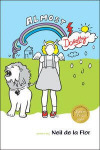Almost Dorothy
Neil de la Flor’s Almost Dorothy is a collection of poetry dealing with issues of sexuality, the past, and coming of age. AIDS is a recurring theme, as is death. The world he writes in isn’t inviting or pretty, yet he seems to find humor in it and approaches it in a playful way.
Neil de la Flor’s Almost Dorothy is a collection of poetry dealing with issues of sexuality, the past, and coming of age. AIDS is a recurring theme, as is death. The world he writes in isn’t inviting or pretty, yet he seems to find humor in it and approaches it in a playful way.
These narrative poems are disjointed and lengthy. They mix genres, jumping from nonfiction to interview, visual art to text book definitions. Pop-culture and scientific references abound. With so much going on in one book, it can sometimes be hard to follow.
There are threads, however, that seam this hodge-podge together: his love of long lines, associative thinking, the reoccurring character of his gay friend Joey, who is introduced in the first poem “Introduction,” where he tells a story that is simultaneously funny and sad – “the closest he’s felt to a man” resulting from two men having sex beside him. This is picked up on later in the book – he is never quite part of things, always observing from a distance, friends and relatives becoming characters in a play, himself even becoming a character in poems such as “Interview with Mr. De La Flor,” an intense and comedic interrogation over him assaulting a lover in his sleep. Interviews are seen again in the book, in the poems “Why” and “The Invisible Chromosome.”
A tendency towards playwrighting emerges again in “The Elegant Universe,” “In Toto,” and “He Tries His Tongue,” which features parts and actors – “a girl (as a clown) and a boy (as a Doberman).” The poem “In Toto” has less conventional characters such as “Baseline,” “Casual,” and “Darling,” which brings to mind the chorus of Greek tragedies.
Visual art interrupts the poems “Especially, Death” and “Memoir of a Barbed Wire Fence.” While this can be a gimmicky addition to a poem in many cases, both instances of visual art are either self-portrait (“Memoir of a Barbed Wire Fence”) or his attempt to draw people (“Especially, Death”). The visual art ties into the speaker’s search for identity.
The first instance of definitions comes in the prose poem, “Joey and the Banshee,” where he defines “Banshee: In Gaelic folklore, a spirit of a woman who appears, wailing, signals that somebody in the household is going to die,” which simultaneously introduces the theme of death which runs throughout the book. The author’s associative tendencies also arise in this poem – “1492: Christopher Columbus. Columbus, Ohio. The Buckeye State. Black eye peas. Bratwurst. In Toledo I met a man named Chris. He ran a Christmas shop stocked with Santas and snow. Summer Sale, the sign read. He sold me my first set of pinecones and a bunch of mistletoe." A reference to history, then one word building off another until it develops into one of his memories.
The poems in this collection perhaps work, in total, as a collective group of associations as de la Flor grasps at his past to understand who he is. The grab-bag of genre is a way to look at a subject in a prismatic way, from every angle, and the subject he is looking at is, ultimately, himself and how he fits into his role as a gay man.
Almost Dorothy, the deserving winner of the Marsh Hawk Press 2009 Poetry Prize, is a poetry collection with many levels, all of which are entertaining and a pleasure to read.





